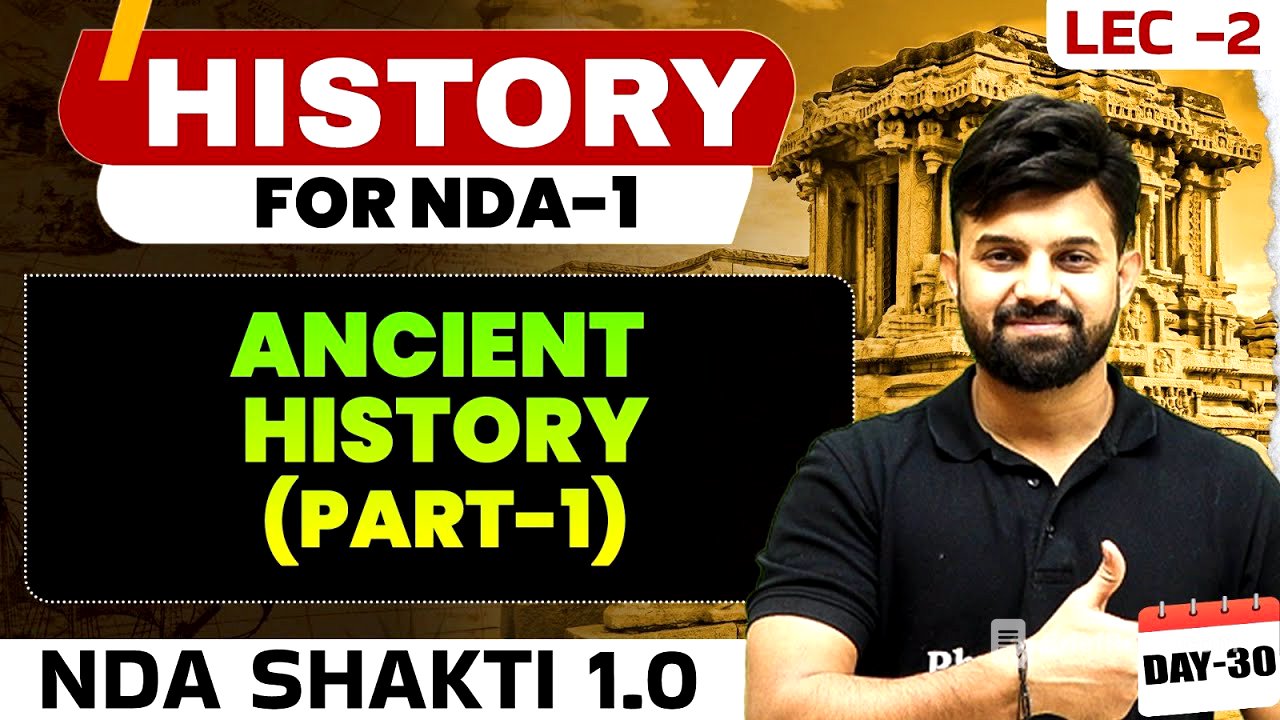TLDR;
This YouTube video by Defence Wallah provides a detailed overview of Ancient Indian History, focusing on key topics relevant for competitive exams. The lecture covers the meaning of history, its importance, and the different phases of historical study: Pre-History, Proto-History, and History. It also highlights the significance of the Indus Valley Civilization (IVC), the Aryan migration, and the Vedic period, including the political, social, and economic structures of these eras. The video aims to provide a comprehensive understanding of ancient Indian history, emphasizing the importance of both factual knowledge and contextual understanding.
- History is divided into Pre-History, Proto-History and History.
- IVC, Aryan Migration and Vedic Period are important topics.
- Aryan culture is divided into Early Vedic and Later Vedic periods.
Introduction [0:04]
The instructor, Prathamesh Ranjani, welcomes everyone to the Defence Wallah platform, confirming that both audio and video are clear. He emphasizes the importance of maintaining a positive attitude, especially when facing challenges, a key attribute for officers. He outlines the plan for the history lectures, which include Modern, Ancient, Medieval, and World History, assuring that any topics seemingly missed will be covered in later sessions.
Importance of History [5:20]
History is defined as events that have happened in the past, and understanding it is crucial to avoid repeating past mistakes. While it's important for exams, knowing Indian history is vital for understanding the country's identity and progress. The instructor highlights two ways to learn history: through stories and through facts, advocating for a balanced approach that combines both for better understanding and exam preparation.
Historians [8:52]
The lecture introduces Herodotus as the "Father of History" globally, while Kalhana is recognized as the first Indian historian. The discussion then shifts to the starting point of history, identifying it as the beginning of human civilization, with the earliest evidence of humans found in Africa. The evolution of humans is discussed, noting the transition from early hominids to Homo sapiens, emphasizing the significance of the discovery of fire as a major milestone.
Three Parts of History [15:24]
History is divided into three parts: Pre-History, Proto-History, and History. Pre-History is the era with no written records, relying on archaeological evidence like fossils and cave paintings. Proto-History includes eras where writing existed, but it hasn't been deciphered, like the Indus Valley Civilization. History refers to periods with deciphered written records, allowing for a clearer understanding of events.
History Divided [24:26]
The phase of history is further divided into Ancient, Medieval, and Modern periods. Ancient History includes the Indus Valley Civilization, Mauryan Empire, and Gupta period. Medieval History starts with the Arab invasions of India, and Modern History begins with the arrival of Europeans.
Indus Valley Civilization (IVC) [26:47]
The lecture transitions to the Indus Valley Civilization (IVC), emphasizing its significance as one of the four major ancient civilizations. IVC is defined by its urban planning, developed language, trade, and worship practices. The four major civilizations are identified as Mesopotamian, Egyptian, Indus Valley, and the Wang Ho Civilization in China. The Indus Valley Civilization is highlighted as the largest and most developed among these.
Discovery of IVC [35:11]
The discovery of IVC is credited to Charles Mason, who first reported the existence of ancient mounds in the Punjab region. Alexander Cunningham is noted for his explorations and reports on Harappa, leading to further investigations. The IVC spanned across modern-day Afghanistan, Pakistan, and India, with major sites including Harappa, Mohenjo-daro, Dholavira, and Lothal.
Geographical Extent and Key Features of IVC [41:51]
The IVC is described as a triangular civilization, with its area spanning approximately 1,299,600 square kilometers. The civilization's timeline is estimated from 3300 BC to 1400 BC, with a mature phase between 2600 BC and 1900 BC. The lecture identifies key geographical points: Manda in Jammu and Kashmir (North), Daimabad in Maharashtra (South), Sutkagendor in Balochistan (West), and Alamgirpur in Uttar Pradesh (East).
Key Cities of IVC: Harappa and Mohenjo-daro [52:16]
Harappa, discovered by Daya Ram Sahni, was the first city of the IVC to be excavated. Mohenjo-daro, meaning "the mound of the dead," was discovered by Rakhal Das Banerjee in 1922. Key features of Mohenjo-daro include its town planning, religion, script, and trade practices.
Town Planning and Features of IVC [54:55]
The town planning in IVC was advanced, with well-organized cities divided into two parts: the Citadel (higher area for the elite) and the Lower Town (for common people). Cities featured grid-pattern roads, advanced drainage systems, and houses made of burnt bricks. The Great Bath in Mohenjo-daro is highlighted as a significant structure, possibly used for ritual bathing.
Economic and Social Aspects of IVC [1:12:44]
Agriculture was a primary occupation, supported by the proximity to rivers. The civilization traded with Mesopotamia, using seals for authentication. The society was divided into different classes, with evidence of religious practices, including the worship of Pashupati and Mother Goddess. The script remains undeciphered, and the civilization used a bronze-based technology.
Decline of IVC [2:02:23]
The decline of the IVC is attributed to several factors, including floods, climate change, Aryan invasions, and trade decline. The mature phase of the civilization lasted from 2600 BC to 1900 BC, with its eventual decline around 1400 BC.
Aryan Migration and the Vedic Period [2:06:18]
The lecture introduces the Aryan migration theory, suggesting that Indo-Aryans migrated from Central Asia around 1500 BC, bringing with them the Vedic culture. The term "Aryan" means "noble" or "pure." The video discusses different theories about the origin of Aryans, including the Central Asian theory by Max Müller and alternative theories by Bal Gangadhar Tilak and Dr. Sampurnanand.
Early Vedic Period: Society and Culture [2:19:39]
The Early Vedic Period (1500-1000 BC) is characterized by a pastoral society, with cattle and horses being central to their economy. The Aryans settled in the Sapta Sindhu region, and their society was tribal, with the "Jana" as the largest political unit. The Rigveda is the primary source of information about this period, highlighting the importance of deities like Indra, Agni, and Varuna.
Political and Social Structure of Early Vedic Society [2:38:13]
The political structure was tribal, with the "Kula" (family) as the smallest unit, headed by "Kulapa." The "Grama" (village) was headed by "Gramini," and the "Vish" (clan) by "Vishpati." The "Jana" (tribe) was the largest unit, headed by "Janasya Gopa." The lecture also discusses the "Dasarajna War," a battle between King Sudas of the Bharata tribe and a confederation of ten tribes.
Religious Practices and Social Norms in Early Vedic Period [2:49:47]
The religious practices of the Early Vedic Aryans centered around nature worship and fire rituals (yajnas). The society was primarily pastoral, with agriculture playing a secondary role. The lecture also touches upon social norms, including the absence of a rigid caste system and the presence of widow remarriage.
Transition to Later Vedic Period [3:06:11]
The lecture marks the transition to the Later Vedic Period (1000-600 BC), noting significant changes in political, social, and economic structures. The focus shifts to the emergence of kingdoms, the consolidation of power, and the development of social hierarchies.
Political and Social Changes in Later Vedic Period [3:07:27]
In the Later Vedic Period, the "Rajanya" (chief) gains more power, and the position becomes hereditary. The "Sabha" and "Samiti" lose influence, and women are excluded from these assemblies. The concept of "Rashtra" (state) emerges, and the society becomes more structured with the rise of the four "Varnas" (social classes).
Economic and Religious Developments in Later Vedic Period [3:25:51]
Agriculture becomes more prominent with the use of iron tools, leading to surplus production. The lecture also discusses the emergence of new religious concepts, including the idea of "Moksha" (liberation) and the growing importance of rituals and sacrifices.
Vedas and Upanishads [3:27:02]
The four Vedas—Rigveda, Samaveda, Yajurveda, and Atharvaveda—are discussed, along with their significance. The Upanishads, philosophical texts that explore the nature of reality and the self, are also highlighted.
The Rise of Mahajanapadas [4:05:14]
The lecture concludes with an introduction to the Mahajanapadas, the 16 major kingdoms that emerged in ancient India around 600 BC. These kingdoms marked a shift towards urbanization, centralized power, and complex political systems. The lecture mentions key Mahajanapadas like Kashi, Kosala, Gandhara, Avanti, Anga, and Magadha, setting the stage for future discussions on their individual histories and contributions.









